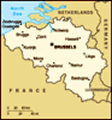Advertisement
Published: March 31st 2018

 Easter chocolates on display
Easter chocolates on display
The Chocolate Line, StevinspleinOnce again, overcast and chilly temperatures discouraged us from taking our canal cruise this morning. So we decided to have a light lunch in the apartment, and then visit a former hospital which is now home to several masterpieces by Hans Memling, one of the preeminent artists of the Flemish Primitive period.
As we walked toward the hospital and museum, there appeared to be a few restaurants and small shops closed for the Easter holidays, but there were plenty of locals and tourists scurrying around the streets.
Of course, the many purveyors of chocolate were doing a booming business! We stopped briefly at The Chocolate Line, one of the many designer chocolatiers in Bruges, where customers can observe part of the (mostly automated) production process. There was quite a queue in the check-out line, as many people appeared to be buying Easter gifts.
The Hospital of St. John (
Oud Sint-Janshospitaal), which is one of the oldest preserved hospital buildings in Europe, was a medieval hospital founded in the mid-12th-century. Located next to the Church of Our Lady, it became a refuge where sick pilgrims and travelers could receive care. The site was later expanded with the building of
a monastery and convent. In the 19th-century, further construction led to a hospital with eight wards around a central building.
After it had evolved into a hospital, it remained a working clinic until 1978, when a new modern hospital was built outside the town center. Today, in the former hospital chapel, the focus is on the work of the most famous of the Flemish painters, Hans Memling, who lived and worked in Bruges during the 15th-century. Memling created his most important masterpieces here, including the stunning "Shrine of St. Ursula", which was created specifically for the hospital.
The museum turned out to be very impressive, despite minimal lighting conditions inside the old building and chapel, with several of Memling's masterpieces prominently displayed. We particularly enjoyed his "Shrine of St. Ursula", a jewel-like relic which occupies pride of place in a glass-enclosed cubicle. The shrine is a carved and gilded wooden reliquary containing oil on panel inserts by Memling in 1489, and was commissioned by the Hospital of St. John.
According to Wikipedia, "Saint Ursula (Latin for 'little female bear') is a Romano-British Christian saint. Her legend is it that she was a princess who, at the request
of her father King Dionotus of Dumnonia in south-west Britain, set sail along with 11,000 virginal handmaidens to join her future husband, the pagan governor Conan Meriadoc of Armorica. After a miraculous storm brought them over the sea in a single day to a Gaulish port, Ursula declared that before her marriage she would undertake a pan-European pilgrimage. She headed for Rome with her followers and persuaded the Pope...to join them. After setting out for Cologne, which was being besieged by Huns, all the virgins were beheaded in a massacre. The Huns' leader fatally shot Ursula with a bow and arrow in about 383 A.D."
The shrine itself is in the shape of a Gothic chapel, with a steeply pointed cover, which was typical of northern European countries at that time. At the sides, under two small arcades, are six scenes of the life and martyrdom of St. Ursula. There are three painted panels on each side which depict, on one side, the First Eleven Virgins with the Pope, a Cardinal, a Bishop and Etherius (characters of the saint's legend); on the other side side, the Coronation of the Virgin with the Holy Trinity.
Another of Memling’s masterpieces
on display in the former chapel is "The St John Altarpiece", a large oil-on-oak, hinged-triptych altarpiece completed around 1479. The altarpiece consists of five paintings – a central inner panel and two double-sided wings. Those on the reverse of wings are visible when the shutters are closed, and show the hospital donors flanked by their patron saints. The interior has a central panel with the enthroned Virgin and Child flanked by saints; the left wing features episodes from the life of John the Baptist, with emphasis on his beheading; and the right wing shows the apocalypse as recorded by John the Evangelist.
After viewing several other of Memling's masterpieces, we toured the old hospital's apothecary, as well as some rather gruesome displays of the crude medical instruments used back in the day, before walking back to the apartment. At the terrace of a small cafe, on the Stevinplein square, we made a pit stop for a couple gins and tonic, while sharing a plate of frites. When we reached the apartment, we popped our heads into Oyya, our personal waffle and gelato outlet downstairs, for some takeout: a waffle with strawberry topping for Dee, and a mocha milkshake for

 Ginny time...
Ginny time...
Cafe on the Stevinpleinme!
Dee's comments: Went to the grocery store while Mitch worked on the blog; then made some lunch before heading out to the museum. St. John's Hospital was very interesting, especially the shrine and other paintings. Took our time on the way back, stopping for some "ginnies" while people watching from the cafe. Visited a neat little chocolate factory and store. Made a quick dinner of bratwurst sandwiches tonight, and later ate my waffle from downstairs (which was excellent!). I've noticed lots of school children in the museums, and out on the streets - perhaps because of the holiday?
P.S. We have now been gone 46 days, traveling in cold weather mostly, so our skins look like lizards! We need to soak in vats of olive oil! LOL
Advertisement
Tot: 0.049s; Tpl: 0.012s; cc: 7; qc: 23; dbt: 0.0209s; 1; m:domysql w:travelblog (10.17.0.13); sld: 1;
; mem: 1.1mb


























Jeni
non-member comment
I think I would have jumped into the vat of milk chocolate, screw the olive oil! ? the history and art are truly amazing there. Thanks for sharing all you are learning.